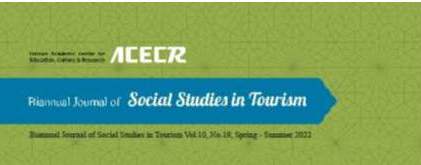-
-
List of Articles
-
Open Access Article
1 - Exploring the Factors Involved in Increasing Attractiveness of Tourist Destinations
Ali Amiri mehrshad toulabi nejad Monirah Ghofran -
Open Access Article
2 - Developing Contemporary Arts’ Tourism in Iran: Challenges and Requirements
Somayeh Momeni Nazanin Tabrizi Mohammad Hassan Zaal -
Open Access Article
3 - Identifying and Prioritizing Factors Affecting Tourism Competitiveness in Tehran
Hossein Farhadikhah Keramatalah Zayyari saeed zanganeh Nasser Rezaei -
Open Access Article
4 - Identifying the Requirements and Challenges of Applying Social Manufacturing to Handicrafts
vahid sharifi Gholamreza Hashemzade Khorasgani Seyed Alireza Derakhshan Ashraf Shahmansouri Abotorab Alirezaee -
Open Access Article
5 - Designing a Model for Effective Strategic Factors in Attracting Investors to the Tourism Industry Using a Mixed-Method Approach
Arash Farhoudi Seyyed Mahmoud Shabgoo Monsef Ali Gholipour Soleymani -
Open Access Article
6 - Analyzing Ideological Attitudes of Modern Tourists Towards Visiting Natural Attractions: A Case Study of Tourists Visiting Western Kalate of Bastam District, Shahrood County
tahereh sadeghloo fahimeh jafari fahimeh karimiyan
-
The rights to this website are owned by the Raimag Press Management System.
Copyright © 2017-2025







